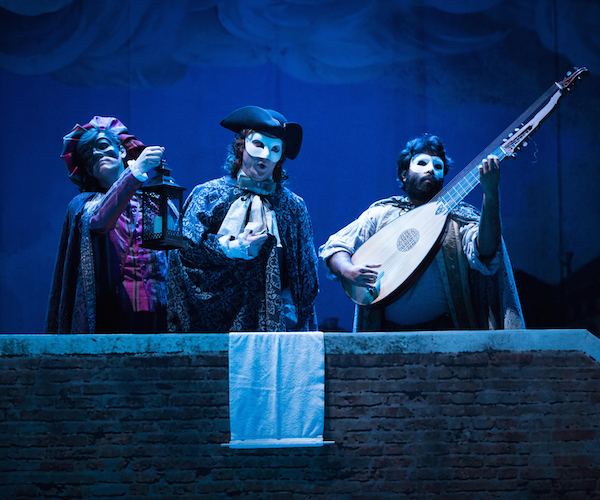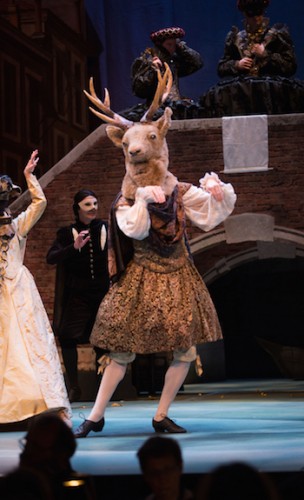Opera Review: BEMF’s “Le Carnaval de Venise” — A Delightful Triumph
Chock-full of truly delightful music, the production scores as yet another BEMF opera triumph.

David Evans, Jesse Blumberg, and Ryaan Ahmed in the BEMF production of “Le Carnaval de Venise.” Photo: Kathy Wittman.
By Susan Miron
June 11 through 18, the 19th Boston Early Music Festival blew into town, serving up its distinctively grand, historically-informed style of entertainment — eight days of almost non-stop concerts, masterclasses, a multitude of symposia, a sprawling, fascinating exhibition, and four superb, critically acclaimed performances of André Campra’s opera Le Carnaval de Venise at Boston’s Cutler Majestic Theater.
With this piece, Campra (1660-1744), born to an Italian father and French mother, composed the first opéra-ballet set in Venice, which was then an independent state. Written after his first opera, L’Europe gallant, Carnaval was first performed on 20 January 1699 by the Académie royale de music in the Salle du Palais-Royal in Paris. The Boston production, prepared in partnership with the Centre de musique baroque de Versailles, marks the opera’s first performance in North America. An over-three hour feast of joy and amusement, Carnaval contains an opera within an opera (within an opera!), a wide variety of dances, and plenty of opportunities for sublime singing. Chock-full of truly delightful music, the production scores as yet another BEMF opera triumph.

Julian Donahue in the BEMF production of “Le Carnaval de Venise.” Photo: Kathy Wittman.
Why are BEMF’s operas so extraordinary, time and again? The first to praise is Stage Director Gilbert Blin, who, for this production, wrote an illuminating sheaf of program notes. (This was a very highly researched production — the result was a new performing edition.) He also designed the wonderfully inventive sets that — along with Campra’s music — evoke the Parisian carnival spirit. Anna Watkins’ costumes were, as always, suitably fabulous. Caroline Copeland, who choreographed the production’s Baroque dances for the singers and dancers, also did some hoofing. Melinda Sullivan, the Director of Dance, trained everyone, acting as the dancers’ outside ‘eye.’ BEMF’s Co-Directors, lutenists Paul O’Dette and Steven Stubbs, led the virtuoso Festival Orchestra from their theorbos; superb Concertmaster Robert Mealy headed an excellent five-part string orchestra. Assistant Stage Director Ellen Hargis translated Jean-François Regnard’s libretto; she also wrote some of the helpful historical program notes. The indefatigable Kathleen Fay served as the Executive Producer.
Gilbert Blin explains the context of the opera:
For the spectators of opera in 1699, the interest was twofold: to see once again the character types of the comedy dell’arte and to become familiar, in the mirror of the opera stage, with the Venetian manners of their time. Le Carnaval de Venise has this boisterous Italian theatrical tradition with all the musical sophistications of French opera— chorus, rich orchestration, and dance — to offer a charming yet revealing image of Venice, where the first opera house was built.
The large cast of singers, many of whom appear regularly in BEMF productions and operas, was headed by Amanda Forsythe (Isabelle, Leander’s beloved), Karina Gauvin (a Venetian lady also in love with Leandre), Jesse Blumberg (Leandre, a French Calvaryman), and Douglas Williams (Rodolphe the Noble Venetian, Leander’s rival for Isabelle). BEMF luminaries who contributed to the hilarity and beautiful harmonizing were the comic tenor Jason McStoots (who always steals the show), Teresa Wakim (A Happy Shade), and the Grammy-winning Aaron Sheehan as a bewigged and befuddled Orfeo. Other stand-outs were Mireille Lebel as Minerva, Christian Immler as Pluto, and Molly Netter as Euridice (in the opera-within-an-opera-within-an opera Orfeo nell’inferi.)
Fusing the elegance of French dance with the rowdy hijinks of commedia dell’arte, Carnaval deploys most of the cast’s singers in at least two roles. The narrative opens with Minerva (Lebel) who, along with other divinities, are preparing a show for “a new holiday” — the Carnival in Venice. The next three acts involve a quartet of wannabe-lovers as well as the performance of the opera inside of this opera, which centers on Orfeo in the underworld. The spectacle ends with a masked ball that celebrates the holiday with feasting, gambling, and romance. Suffice it to say that there wasn’t a dull moment along with way, especially given a BEMF production that was, in every way, enthrallingly entertaining.
Susan Miron, a harpist, has been a book reviewer for over 20 years for a large variety of literary publications and newspapers. Her fields of expertise were East and Central European, Irish, and Israeli literature. Susan covers classical music for The Arts Fuse and The Boston Musical Intelligencer.
Tagged: André Campra, Boston Early Music Festival, Gilbert Blin
